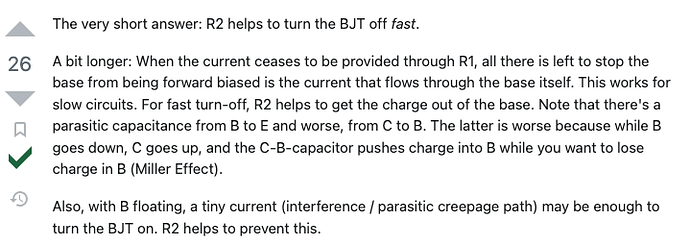@quozl / @ToyBuilder I’m at it again ![]()
This is a follow on from my last post MOSFET Pull-Down but this time on BJTs (NPN)
I was looking at the schematic for the IoT 6 Click from Mikroe (https://download.mikroe.com/documents/add-on-boards/click/lte_Iot_6/lte-iot-6-click-schematic-v100.pdf)* specifically this section

looking at the BJT attached to the PWR label, my understanding is that the purpose here is to be able to use the AN pin on the header to pull PWR_ON to ground and there by powering on/off the module (the same effect as the pushbutton would have). Similarly the BJT on the RESET pin allows the module to be reset.
As is my way, I started to think about the role R1/R2 is having - especially R2 (R1 being to limit the base current of course). Digging my Art of Electronics out, page 63 as the Transistor switch

neglecting the pull-down (and indeed this is the most common variant I have seen and used). Googling turns out some useful material - this StackExchange post was a good read: Why pull base of BJT switch? - Electrical Engineering Stack Exchange

(thankfully we’re all using R2 designator!) - the main explanation is all fine and aligns with the common usage of an NPN as a switch. Also ensuring the base is low rather than floating. the last statement I reckon I’m ok with - if you have leakage current from collector to base, you have a path for it, and as long as the voltage across R2 is lower than the Vbe threshold, the transistor will remain off.
so far so good! But I found the following video - https://www.youtube.com/watch?v=6sXCqDel6oA (@ToyBuilder, I watched it at 0.25x first this time!); looking at this screen grab has got me scratching my head somewhat and wondering if I missed something or this might be a mistake…

“pull down resistor prevents stray signals” - experimentally he touches the base resistor (with no pulldown) coupling external AC into the base and switching on the transistor; he adds the pull-down and the current into the base is reduced and the transistor remains off (companion video - https://www.youtube.com/watch?v=HKnGkQJR-1Y).
What I see is that the 10K Pull down is before the base resistor, which I can’t see as having any useful effect. Any stray EMF induced (“stray signals”) would still induce a current into the base of the transistor right? and leakage current from the collector is more likely to be injected back into the base. If the pull down was connected to the transistor base (as in all the other diagrams above) then I wouldn’t have an issue, but its not… have I missed something?
* small aside - am I the only one who finds this style of schematic annoying to read? ![]()
